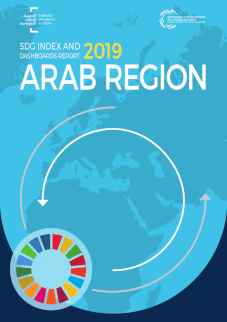More details
Executive Summary
The 2019 Arab Region SDG Index comprises 105 indicators, each of which have an assigned score (0–100) and a traffic light colour (green, yellow, orange, or red) to indicate performance. In addition, arrows indicate trends in progress towards achieving the goals for those indicators where data for multiple years are available.
Compared to the Sustainable Development Report 2019, which contains the SDG Index and Dashboards for all UN Member States, the Arab Region Index introduces 30 new indicators that reflect regional priorities and challenges. The selection of these indicators, along with related thresholds, was greatly informed by two rounds of regional expert consultations, which were conducted in May and August 2019 and collected more than 200 comments from more than 40 individuals. The regional Index also removes indicators that are not useful or relevant for the region or where data coverage is currently insufficient.
In addition, the 2019 Arab Region Index includes Palestine, which has so far not been included in the global SDG Index reports. It also provides a total SDG achievement score for two countries – Libya and Somalia – that did not receive one in the global Index due to low data availability.
The main findings of the study are:
-
The region displays a wide range of sustainable development outcomes, with common challenges around sustainable food production systems and gender equality, among others. The variances between the 22 Arab countries reflect their very significant differences in performance on many socioeconomic indicators. Only a few common denominators are universal in the region, including poor performance on SDGs 2 (Zero Hunger) and 5 (Gender Equality). There are also significant challenges in SDGs 3 (Good Health and Well-being), 6 (Clean Water and Sanitation), 7 (Affordable and Clean Energy), 8 Decent Work and Economic Growth), 9 (Industry, Innovation and Infrastructure), 14 (Life below Water) and 16 (Peace, Justice and Strong Institutions), which cut across the region. Other SDGs show more variation, which makes overarching policy recommendations difficult – responses and solutions need to be country- and context-specific.
-
Five countries are two-thirds of the way to achieving the SDGs. In 2019, five countries emerge as regional leaders, with a total index score of 65 or above. These are Algeria, the United Arab Emirates, Morocco, Tunisia and Jordan, in descending order. Taken as a whole, the Arab region does not score high in terms of SDG attainment, with an average score of 58 out of 100. With only a decade left to achieve the 2030 Agenda the region needs to accelerate efforts in all areas of sustainable development.
-
Poor and conflict-affected countries face the highest risk of falling behind. Overall, the 22 Arab countries receive a red score for 51% of all the 17 SDGs. The region’s six Least Developed Countries (LDCs) and two other countries suffering from conflict, Syria and Iraq, each have more than 10 SDGs in ‘red’ in the SDG Dashboard, indicating that they are far from achieving these Goals. These countries will require tremendous efforts both domestically and by their regional and international partners to ensure they are not left behind.
-
There is positive momentum in two important areas relating to environmental sustainability, water and climate change. Several countries are on track to achieving SDG 6 (Clean Water and Sanitation) and SDG 13 (Climate Action), and there are moderate increases in performance across several SDGs. From an environmental security perspective, achieving sustainable water systems and addressing climate change are crucial. Overall, however, only a total of four of the 17 SDGs have so far been achieved in three countries of the region (Iraq, Jordan and Lebanon). This means that 19 countries have not yet achieved a single SDG.
-
Significant gaps remain in data necessary to measure sustainable development performance in the region, particularly relating to income and wealth distribution. The most significant data gaps are currently found on SDG 1 (No Poverty) and SDG 10 (Reduced Inequalities). In both areas, the gaps are the result of lack of data on income and wealth distribution. No publicly-available regional datasets were identified in the process of developing the 2019 Arab Region SDG Index. The Arab region should urgently invest more attention and resources to generating and making available data in the areas outlined above. This will be essential not only for tracking SDG performance but also to enable data-driven, science-based planning and decision-making.
Acknowledgements
The authors would like to acknowledge support provided by Seppe Verheyen, Zakareya Mohamed Salman and Jai Bandekar. Invaluable contributions were also made by dozens of regional SDG experts during two rounds of consultation.
